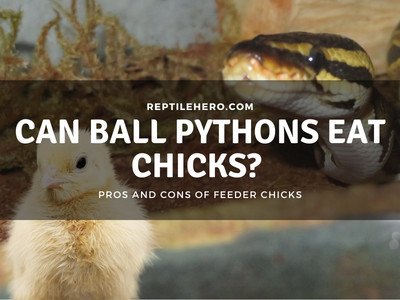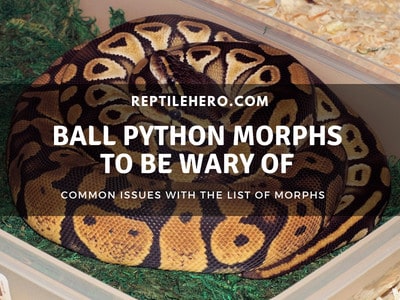13 Ways of Providing Enrichment to Your Ball Python
Is enrichment really that important for ball pythons? As an owner, you are probably wondering whether or not a ball python can be bored or not. Can they live properly if provided with minimum care and enrichment?
Ball pythons can be provided with enrichment through a larger space, elevated areas, day/night cycle, temperature gradients, provisions, enclosure rearrangement, handling, training, free-roaming, allowing observations, sounds, diet variety, and providing toys.
Ball pythons are often viewed as the pet rock of the snake world. But is this really true? Are there any benefits to them when provided with enrichment? Can they play with toys? Read until the end to know the answers to these questions!
1. Larger Space
The easiest way to provide enrichment to a ball python is to house it in a large enclosure. A minimum of 4x2x2 ft is recommended for adult ball pythons but providing a little bit more than that can be more beneficial.
Unlike what some keepers say, ball pythons “do” roam and explore at certain times of the day. Providing ample space can prevent obesity and stimulate their brain because they can explore.
Of course, if they are kept in an enclosure deprived of space, they would act like a “pet rock” as some keepers mistake them to be.
If you are keeping your ball python in a minimum-sized enclosure, then maybe it’s time to get an upgrade. The best ones at an expensive price range will be custom-made enclosures made from PVC or wood.
However, there are cheaper alternatives like custom-made glass enclosures. For the cheapest one, a converted large plastic bin can also work.
2. Elevated Areas
Providing ball pythons with elevated areas can also stimulate the part of their brain related to roaming. Ball pythons are proven to climb in the wild due to birds being a part of their diet so it is part of their normal behavior.
It is recommended to give them an elevated object or area to climb on for their enrichment. There are many keepers that observe their ball pythons “looking” for a vertical area to climb onto.
You can provide branches, cork barks, mini hammocks, etc. that are angled 45°–65°. Just make sure that they are secured properly with foam spray, silicone, and other reptile-safe adhesives.
3. Day/Night Cycle
Ball pythons should be given a proper day/night cycle to encourage normal activity throughout the day. Lights should operate for 10–12 hours of the day and off for the remaining 12–14 hours.
Ball pythons can both be crepuscular and nocturnal animals—meaning that they are most likely to be active during dawn, dusk, or night.
Keepers who claim that ball pythons do not roam, probably don’t provide it a light source that simulates a proper cycle daily.
A proper day/night cycle can trigger the exploration and foraging response from a python.
However, keep in mind that too much light can stress a ball python while having no light at all can deprive them mentally.
4. Temperature Gradients
For ball pythons, a temperature gradient can function as a source of enrichment. Ideally, their enclosures should be 78–80°F on the cool side, 80–85°F on the middle, and 89-90°F on the warm side.
Ambient temperatures below 74°F and above 92°F are considered harmful to a ball python because they can cause respiratory diseases and overheating, respectively.
Temperature gradients are important because it also triggers a stimulating response for a ball python. This gradient will allow the snake to choose which part of its enclosure to be on depending on its thermal needs.
If it feels too hot then it would probably move to the cool side. Conversely, it will go to the warm side if it feels too cold.
More importantly, ball pythons need these gradients because they are ectotherms, meaning they need exterior factors to regulate their body heat. Without heat, you really won’t see them move at all!
Some examples of great heat sources are halogen heat lamps and deep heat projectors. Both have infrared A and B which penetrate deep into the ball pythons’ skin, warming them deeply.
5. Provisions
While staying inside their enclosures, ball pythons can get enrichment from provisions like hides, water bowls, a thick substrate, and some clutter.
1. Hides
It is recommended to give a ball python at least 2 hides, one for the colo side and one for the warm side. At least 2 hides are provided to give the python options for where it would like to take shelter.
Hides provide shelter for the ball python and it makes them feel secure, especially during the daytime.
Additional humid hides are also great for ball pythons, especially when they are shedding. If you are planning to add one, remember that is should be placed by the middle, closer to the cool side.
There are no risks in adding more hides! Your ball python might even like it since there are more hiding places it can use.
2. Water Bowl
Properly sized water bowls can also be a source of enrichment for ball pythons because it gives them the chance to soak. They might soak due to shed, get rid of external parasites, or cool down.
>>Learn more about why ball pythons soak in our article how long do ball pythons last underwater?
Ball pythons need at least 1 water bowl big enough for them to soak in.
Adding an additional one can also boost the humidity inside the enclosure, especially when placed on the warm side.
3. Substrate
Proper substrate can be a source of enrichment for a ball python because it gives them the chance to burrow into the ground. A depth of 2–4 inches is recommended for ball pythons.
Fun Fact: Ball pythons do not actually make their deep burrows in the wild! Instead, they inhabit burrows made by rodents and termites.
I do not recommend using substrates like paper towels, newspaper, and reptile mats. They will not give a chance for the ball python to burrow and can quickly become unsanitary unless replaced regularly.
Substrates like cocopeat and cypress mulch are good for retaining humidity while aspen bedding can be used by keepers living in already-humid areas.
4. Clutter
Additional clutter like live and fake plants, branches, driftwoods, cork barks, hammocks, vines, and backgrounds can be used as enrichment for ball pythons. These additional items can give the snake a better experience when it is exploring inside the enclosure.
In addition, extra clutter can also give a ball python more security, especially if the enclosure is well-lit.
Just a reminder, though, all clutter must be sanitized properly to prevent mold and bacteria build-up. They can be boiled, baked, or hand-washed with soap and then left to dry before using.
6. Enclosure Rearrangement
Another way to provide enrichment to a ball python is to rearrange its enclosure from time to time. This encourages a ball python to explore more and stay inquisitive when it encounters a new set-up.
You can do this during general cleaning where you can relocate all parts of the enclosure like hides and different clutters.
I also recommend rearranging the enclosure after spot-cleaning by simply moving the clutter around. But don’t transfer its hides if they are still using it.
Like some keepers, I personally do this regularly and often see my ball python, Choco, exploring his in his newly rearranged set-up.
This goes to show that they can recognize changes made in their enclosure and that they are indeed inquisitive creatures!
7. Handling
Handling can improve the tolerance and comfortability of a ball python with its owner which then provides associative enrichment. Choice-based handling is also the best method when interacting with the snake.
If you just want to handle your ball python, it is important to let it come to you out of its own volition. This is important! You have to do this so it can associate you with a neutral part of the environment.
Once you see it showing signs of fear like retreating and being defensive, however, leave it alone. Only come back again when it is out and about in its tank again.
Then continue being in its presence until it becomes curious enough to check you out. This repetitive and slow process will eventually lead to the ball python associating you as a “non-threat.”
Handling should also not be rough. So if you want to play with your ball python, make sure that you are calm and gentle during handling and it should only last for about 10–15 minutes per day.
8. Training
Ball pythons can be trained to improve their handling tolerance and feeding efficiency. There are two common training methods: tap training and target training.
These methods give great enrichment to a ball python. With training, you can stimulate their brains and teach them to associate things like tapping and colors with different activities.
1. Tap Training
You can try out tap training to implement a signal to the ball python that you are in its presence or if it is about to be handled. This method will teach the snake the difference between handling and maintenance from feeding time.
This training is typically done with a hook that is gently tapped and rubbed on the sides of a ball python’s head.
Ideally, this should start when the ball python is still young. What most experts advise is to mainly do tap training for maintenance and handling.
Using this kind of signal can also reduce a ball python’s shyness and fear in your presence.
2. Target Training
In contrast to tap training, target training is commonly done to create a signal for a ball python during feeding time. This is another association training that elicits a feeding response in the python once the target is shown.
The “target” is usually made using things such as lids and cups that have a vivid color like red or blue. It must be long or attached to a long stick to prevent the ball python from accidentally biting your hand.
When implemented correctly, a ball python will learn to come to the target for feeding even when they can not see any food near the target. This will make it easier to coax the snake out of its hide when it’s feeding time.
9. Free Roaming
Letting a ball python free roam inside a room or out in the sun for enrichment. Experiencing outdoor factors like natural sunlight can also be a great experience for them.
It is recommended to let your ball python out once in a while to let it have a new experience other than the limited space in its enclosure. Many keepers share that their ball pythons seem to be lifting their heads up high when roaming outside.
This behavior is called “periscoping” which is what ball pythons do when “scoping” out their environment. This is a sign of a ball python being curious about its surroundings.
>>Learn more about letting a ball python out in our article about taking ball pythons outdoors
You can also bring your ball python with you on the couch when you watch TV. It is unknown whether or not ball pythons do this, but amongst snakes, they seem to like watching shows too.
10. Allowing Observation
Having at least one clear side in its enclosure can allow a ball python to observe what is happening outside. This offers the snake additional mental stimulation and enrichment.
Since he is placed near our dining table, I observe my ball python Choco watching us whenever we are having dinner. He is placed in a glass terrarium so he can see us through it.
He does not seem stressed at all and would often allow handling when he is out and about like this after watching us from his tank.
But the stigma that clear enclosures cause stress to a ball python is true. An enclosure that has clear walls all around can stress a ball python.
However, stress from such an exposing clear tank can be minimized as long as there are ample clutter and hiding places. Such things can make a ball python feel more secure.
11. Sounds
Ball pythons can associate sounds made by their owners with activities like handling and feeding. People’s voices and different music can also serve as enrichment for ball pythons.
I recommend calling out to your ball python before you handle it. Do it whenever you are within the vicinity of its enclosure to let it know you are near as well.
This is another form of enrichment that can also help make a ball python more comfortable in your presence, and humans in general.
In my experience, playing music and my voice can make my ball python more inquisitive. When we are cooking for dinner, we often play music and we sometimes see Choco coming out of his hide curious as to what he is hearing.
12. Diet Variety
Reports show that giving ball pythons a varied diet can also provide enrichment. Besides rats and mice, occasional treats like quails, chicks, and other rodents can be given.
Although not required, a variety in their diet can give additional enrichment to a ball python. It can also improve its appetite as some ball pythons are known to fast for months.
Moreover, most reptile experts and veterinarians recommend giving ball pythons and other snakes with varied diets as much as possible to improve their overall health.
13. Providing Toys

Ball pythons have not been proven to “play” with objects like toys. However, they see these novel items as something to investigate.
Some toys that a ball python might like are hammocks, puzzle feeders, or anything with a tunnel feature.
Just make sure that the snake itself would not get injured or stuck on the toy itself so watch out for toys with tight spaces and sharp edges.
Providing toys is not necessary because tank decors and clutter have the same purpose. However, introducing a novel item to ball pythons from time to time can still benefit them as it is something new and can make them more curious.
Why Enrichment is Important for a Ball Python?
Enrichment is important to a ball python because it improves overall brain function. Moreover, giving reptiles enrichment is part of “best care” husbandry—especially since their native habitats are more complex than their enclosures.
Unlike what most keepers say, it is proven that ball pythons can get bored which can have harmful effects on them if left unaddressed. Enrichment-deprived ball pythons are more prone to stress, obesity, and illnesses.
One study even shows that enriched ball pythons can recognize their owners more easily in comparison to those kept in a minimal setup [2]. This just shows that enrichment can be very beneficial!
Their brains also have similar functions and capabilities as mammal brains [3, 4]. There are many studies that prove they are sentient creatures capable of showing emotions too! So, ball pythons should not be treated as lesser animals than cats or dogs.
>>Learn more about a ball python’s emotions in our article about ball pythons showing affection.
2 Signs a Ball Python Does Not Want to be Disturbed
A ball python does not want to be disturbed if it displays a fight response or a flight response.
During these scenarios, disturbances may lead to stress which can affect a ball python’s feeding and overall health state.
You’re likely also going to get such reactions from snakes if they are still in the process of shedding!
1. Fight Response
A ball python’s fight response is marked by defending itself through aggression or biting. A ball python does not want to be disturbed if it exhibits the following fight-response behaviors:
- Hissing
- Tail-wagging
- Striking position
- High receptiveness
>>Learn more about signs a ball python is about to bite in our article about why your ball python bit you
2. Flight Response
A scared or stressed ball python that does not want to be disturbed may exhibit the following flight responses:
- Balling-up
- Head tucking
- Fleeing
Further Questions
What do ball pythons do for fun?
Fun is not really applicable when discussing a ball python’s behavior. However, they seem to be contented when they have recently eaten or if are given enough secure places to hide in.
How to make a ball python happy?
Ball pythons will be “happy” when their husbandry needs are met. This includes having a proper enclosure size, temperature, humidity, substrate, water bowl, proper meals, and most especially, enrichment.
Summary of Providing Enrichment to a Ball Python
Ball pythons can greatly benefit from enrichment such as having an optimal living space, experiencing owner interactions, being able to explore, getting visual and auditory stimulation, eating a varied diet, and providing toys.
Enrichment is essential for ball pythons to stimulate them mentally and physically. This is essential for them to have a better quality of life. It is proven that a python kept in an enriching environment exhibits less stress and better associations.
A ball python should not be disturbed if it shows signs of fight-or-flight responses. Disturbance during these times, such as shedding, can greatly stress a ball python.







